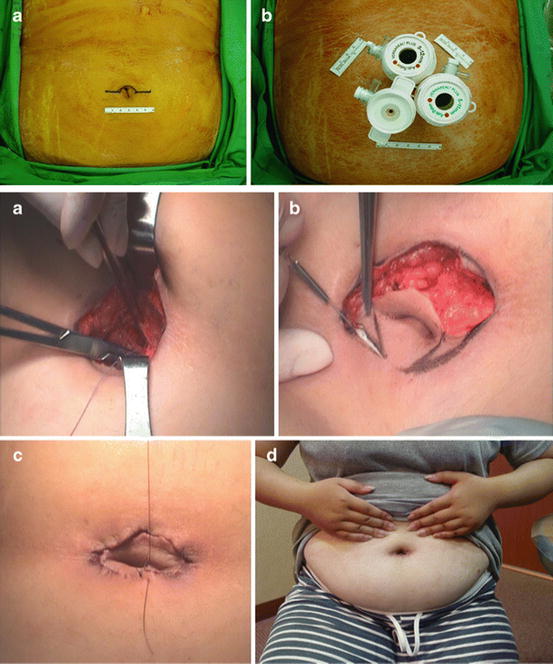Fig. 35.1
Bariatric Procedures
1.
TANKO laparoscopic adjustable gastric banding (LAGB)
TANKO LAGB seems to be the least technically demanding of the TANKO bariatric surgeries. LAGB requires an adjustable port beneath the skin, so a 3-cm skin incision is mandatory. Some surgeons use that skin incision for a TANKO approach [1]. Some use an intraumbilical approach [2] with the interest of cosmesis. There is, however, the possibility of infection in the umbilical area because the adjustable port is a foreign body. Care must be taken to avoid infection. If infection occurs, the adjustable port should be removed immediately.
2.
TANKO laparoscopic sleeve gastrectomy (LSG)
The number of LSGs performed in Japan and worldwide has been increasing recently and is now second to the number of LRYGBs performed worldwide. The most common TANKO bariatric surgery performed worldwide may be LSG. There are two possible approaches for TANKO LSG. One is from above the umbilicus, and the other is from the umbilicus itself. Of course, from the standpoint of cosmesis, the umbilical approach is better. Usually, morbidly obese patients are very large, and the distance from the umbilicus to the xiphoid is too great to reach the upper part of the stomach during the procedure, so some surgeons perform TANKO LSG from above the umbilicus. The only real advantage of TANKO is better cosmesis, so we think the umbilical approach is the only meaningful one. Patient selection is important when considering TANKO bariatric surgery.
We use the RP approach instead of TANKO in consideration of patient safety, as discussed below.
3.
TANKO laparoscopic Roux-en-Y gastric bypass (LRYGB)
LRYGB is a complex procedure that requires two anastomoses. As far as we know, only a few surgeons perform this procedure [5–7]. Some surgeons use the RP approach.
Huang reported the first case of TANKO LRYGB, which was performed via the skin near the umbilicus incision, as shown in Fig. 35.2 [5]


Fig. 35.2
Upper: (a) Omega shape incision and (b) trocar placements. Lower: (a) Fascia closure, (b) Trimming of skin, (c) Skin closure, (d) Scar (see Huang et al. [9])
4.
TANKO laparoscopic biliopancreatic diversion (LBPD)
LBPD is the most effective procedure for morbid obesity, but it performed less frequently than LRYGB. Only a few surgeons perform TANKO LBPD [8].
35.1.2 Objections to TANKO Bariatric Surgery
Bariatric surgery is not easy because the patients treated are morbidly obese. Such patients have significant intra-abdominal fat and a liver enlarged by fatty liver disease; the working space is narrow. These characteristics make exposure of the surgical field difficult and increase the possibility of bleeding and other risks in comparison to the risks conferred by other surgeries.
Traction and counter-traction, triangulation, and surgical exposure are mandatory for safe surgery. The TANKO approach, in comparison to the conventional laparoscopic approach, is disadvantageous in terms of safety because it lacks these features. This is why a number of well-established bariatric surgeons are hesitant to introduce the TANKO approach.
35.1.3 Our Method
Our principal goals for TANKO/RP surgery are as follows:
1.
to give proper consideration to cosmesis
2.
to achieve the same results that conventional laparoscopic surgery achieved in terms of quality of life and long-term outcomes
3.
to provide a safety level equivalent to that of conventional laparoscopic surgery.
We need not to be bound to a certain number of holes. We must maintain safety but strive for the cosmesis realized by “invisible” scars. Some surgeons take cosmesis too lighty, but cosmetic results have a long-term life effect, especially for younger patients, so we pay careful attention to this matter.
The TANKO/RP approach should yield the same outcome as conventional laparoscopic surgery. We need to perform the same procedure in the abdominal cavity, and we cannot shortcut any safety measures, even in TANKO/PR.
Stay updated, free articles. Join our Telegram channel

Full access? Get Clinical Tree








